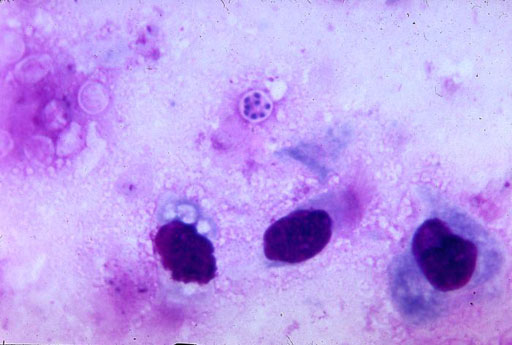New Drug Treatments to Target Pneumocystis Dependence on Inositol Transport
By LabMedica International staff writers
Posted on 29 Dec 2016
A recent paper suggested that the Pneumocystis fungus, a dangerous pathogen that causes pneumonia in HIV patients and other immunocompromised individuals, could be targeted by drugs that would block its inositol transport mechanism.Posted on 29 Dec 2016
Pneumocystis fungi are resistant to most currently prescribed anti-fungal therapies. Furthermore, the gold standard, trimethoprim sulfamethoxazole, often causes serious allergic reactions in many patients.

Image: Pneumocystis jirovecii is present in this lung impression smear, using Giemsa stain. This fungus is arguably the most important cause of pneumonia in the immunocompromised human host (Photo courtesy of the CDC).
Inositol is a sugar alcohol. Its taste has been assayed at half the sweetness of table sugar (sucrose). The most common structural form of inositol, myo-inositol, plays an important role as the structural basis for a number of secondary messengers in eukaryotic cells, the various inositol phosphates. In addition, inositol serves as an important component of the structural lipids phosphatidylinositol (PI) and its various phosphates, the phosphatidylinositol phosphate (PIP) lipids.
Humans and microbes alike can obtain inositol by making it, which involves only two enzymes, by taking it from the environment by a transport process, or by recycling it from other cellular constituents. Inspection of the genomes of the pathogenic fungi of the genus Pneumocystis showed that these pneumonia-causing parasites could not make myo-inositol, as they lacked the two enzymes.
Investigators at the University of Cincinnati (OH, USA), who were studying Pneumocystis, found evidence of inositol transporters, which imported the sugar from the lungs where the fungi resided. In the present report, which was published in the December 13, 2016, online edition of the journal, MBio, they characterized the transport of myo-inositol in the fungus and found that the transporter was highly selective for myo-inositol and did not transport any other molecules.
The inositol transport system was distinct from that in mammalian cells, and since mammals can both make and transport myo-inositol, while Pneumocystis fungi must transport it, this process offered a potential new drug target.
"Identifying a drug to inhibit the transporter will kill these fungi because they cannot synthesize inositol as they lack two enzymes to do so," said first author Dr. Melanie T. Cushion, professor of internal medicine at the University of Cincinnati. "The transporters in humans and Pneumocystis are sufficiently different that inhibitors of the fungal transporter are not likely to impact the mammalian transporters. If that is the case, no toxicity is expected with this new line of drugs."
Related Links:
University of Cincinnati













